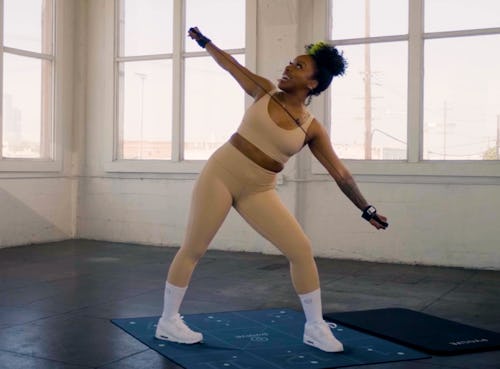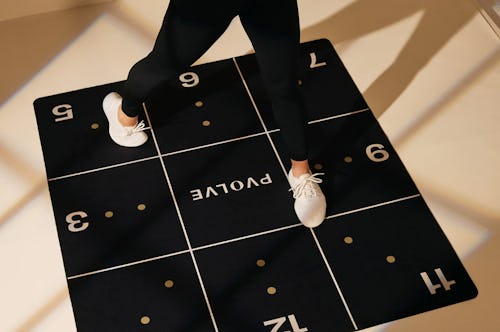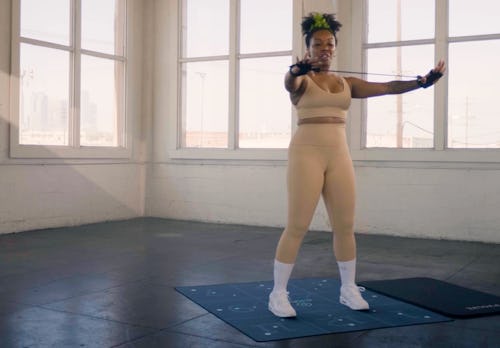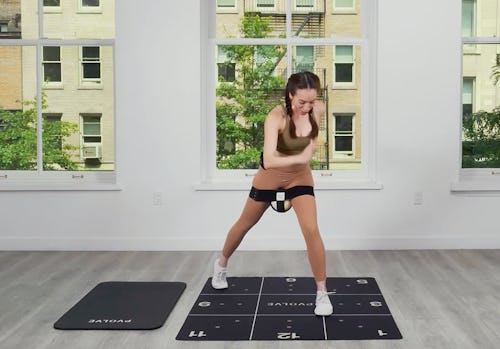Jennifer Aniston knows fitness. The Friends star has been very open about her love of working out throughout the years, and has talked at length about everything from boxing and Pilates to VersaClimber classes.
As of late, her go-to way to sweat is via Pvolve workouts, a platform that’s focused on gentle but effective functional fitness — something that appeals to me as a fan of TikTok-viral low-impact routines like hot girl walks and cozy cardio.
“Our society tells us we have to feel the burn, and that if it doesn’t hurt, [a workout] isn’t effective,” Aniston previously told Bustle. “All of these taglines like ‘no pain, no gain’ are just absolute BS because you can get an incredible workout without feeling like you can never do it again once you’re done.” Preach.
Since I’ve been on a gentle, low-impact workout kick myself, I was intrigued by Pvolve — and had to try it for myself. Read on for my honest review of Aniston’s fave fitness platform after testing it out for two weeks.
The Workout

— Pvolve
Pvolve focuses on functional fitness, strength, and mobility. A typical workout features dynamic movements that work multiple muscles at once for balanced, total body strength training — kind of like Pilates with a twist. But, rather than utilize tools like the reformer, it uses its own specialized equipment that’s designed to help you do the precise movements required in the workouts.
You can take a Pvolve class in person at one of the many studios across the country, on-demand, or via the two-way live virtual studio where members take a live class and directly engage with trainers.
There are different kinds of workouts to choose from: strength and sculpt (a Pvolve signature that hits the entire body), progressive weight training (which incorporates weights), women’s health (focused on pelvic floor support), recover and stretch (to lengthen muscles and ease tightness), cardio burn (featuring more heart rate-spiking movements), and mat definition (a Pilates-inspired floor class).
There are different packages to choose from when you sign up, including the signature bundle, which costs $199.99 and hooks you up with gear, a free month of membership, and a consultation with a trainer. The total transformation bundle ($624.99) gets you a 13-piece home gym, a year of streaming, and a consultation with a trainer. And the streaming membership ($14.99/month) brings you access to hundreds of on-demand workouts and daily two-way live virtual classes.
The Pvolve Equipment

— Pvolve
Pvolve spent years designing a collection of unique resistance-based equipment. Within its collection you’ll find the P.ball, a squishy sphere that wedges between your thighs to help strengthen your core, glutes, pelvic floor, and legs; the P.band elastic that’s used for strengthening your upper body and improving posture; and the P.3 Trainer, which is a dynamic, full-body toning system.
You can also pick up other tools on the brand’s website, like gliders, ankle weights, and a slant board to create your own at-home gym.
What really stands out, though, is the brand’s Precision Mat, which was designed to improve your body awareness. As you exercise, Pvolve trainers will instruct you to stand on different numbers or lines on the mat to ensure you’re targeting the right muscles and moving in the most effective ways.
Inside The Sweat Sessions

— Pvolve
Pvolve offers plenty of equipment-free workouts, but I first tried an on-demand video with trainer Renée Settle that used both the band and the mat so that I could put my nifty new tools to the test.
Settle’s upper body workout started with a big, bendy warmup followed by 30 minutes of stretchy, strengthening arm movements. It took me a hot second to get the hang of the P.band, but Settle walked me through it — and before I knew it, I was stretching my arms to and fro with it like a pro.
While many upper body routines involve dumbbells or push-ups, I loved that this workout was super low-impact and mostly done standing up. The resistance came fully from the P.band, which was securely attached to my hands.

— Pvolve
Whether I was lifting my arms up and apart or pulling one back like an archer, I felt each move hitting all the muscles in my arms, while also strengthening and stretching my back for better posture.
Throughout the workout, Settle suggested I pay attention to the exercises or areas that felt the most challenging since that might represent what I need to work on, possibly due to a muscle imbalance caused by my day-to-day life. As someone who huddles over a computer all day, I definitely felt the moves that targeted my upper back the most, so she seemed to be spot-on.

— Pvolve
To take the P.ball for a spin, I tried a 27-minute lower body routine with trainer Julieann Earls. We started with a warmup before shimmying into the P.ball, which fits securely between your thighs using a hook-and-eye attachment. (As a note, if you have larger thighs, it might be too small.)
This workout utilized the numbers on the precision mat. As we moved through thigh-squeezing movements, Earls recommended I stand with my right foot on the number one in the upper right corner of the mat. By planting my foot in the correct spot and keeping it there, I was able to internally rotate my hips and target my glutes in a brand new way.
The class featured a lot of athletic stability poses, staggered running stances, and in-and-out thigh abduction and adduction movements with the ball. The entire time, I found it so helpful to look down and check that my feet were in the right spot.
It became a little tougher to maintain balance as I got sweatier. But according to Earls, falling out of a pose is actually a good thing, as it means you’re “teaching your body how to catch you.” Pvolve is, after all, about improving your functional movement for everyday life.
The Verdict
What sets Pvolve apart, IMO, is the equipment. Between the precision mat, the Pilates-like P.ball, and the P.band, the workouts end up feeling precise, effective — and totally unlike any other type of exercise I’ve done before.
As someone who always forgets about my form during a workout, I found it extra beneficial to have tools help keep me in the right position throughout each class.
Instead of wobbling my way through a routine, I liked that I could rely on the P.ball or the P.band to zero in on all the right muscles. I’m also a big fan of the low-impact nature of it all; while I definitely got sweaty, I never felt drained or overly exhausted — just like Aniston had promised.
After doing Pvolve for a couple of weeks, I’ve noticed that I have better balance, my hips seem more loose and mobile, and simple movements — like bending down to pick up my dog — are 100% easier. As for my verdict? I’d say it’s a nice change from Pilates and other low-impact routines, and is definitely worth a try.
Studies referenced:
Byrnes, K. (2018). Is Pilates an effective rehabilitation tool? A systematic review. J Bodyw Mov Ther. doi: 10.1016/j.jbmt.2017.04.008.
Enjoyed this article? Sign up for our newsletter to receive regular insights and stay connected.

